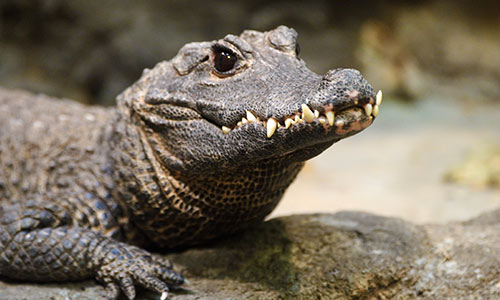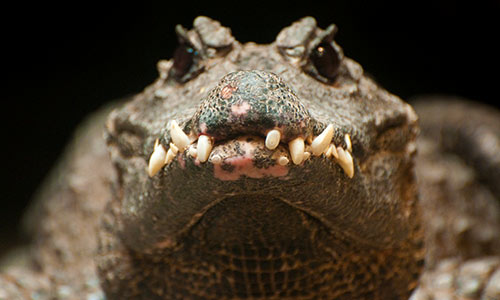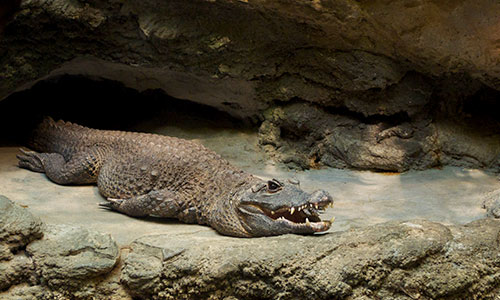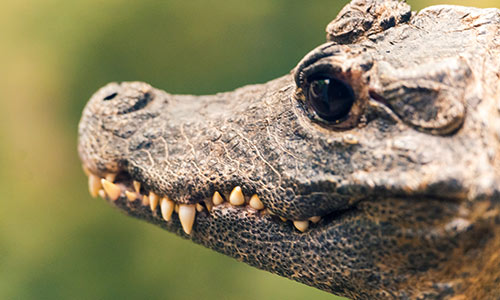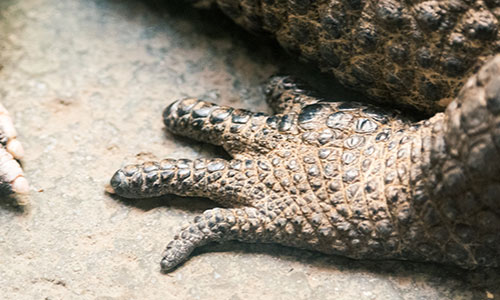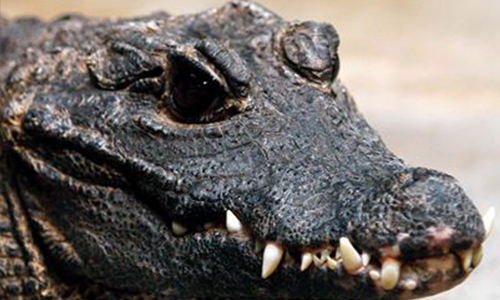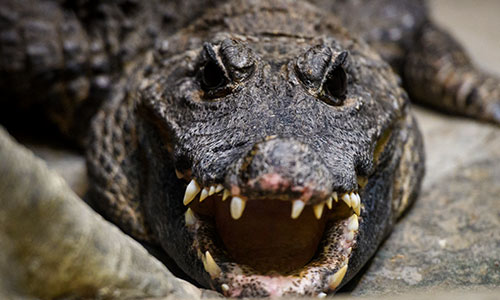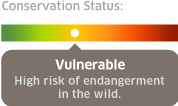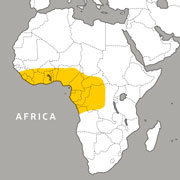Appearance:
West African dwarf crocodiles have a snout that's characteristically short and blunt; their razor-sharp teeth number 30 to 32. Unlike a number of other animal species, dwarf crocodiles continuously grow and replace their old teeth, which are pushed out by new teeth developing below.
Juveniles have light brown banding on the body and tail and yellow patterns on the head. When fully grown, its back and sides are black and the underbelly is yellowish in color with black patches. The belly and underside of the crocodile’s neck have bony deposits that form hard plates (osteoderms), and its neck, back and tail are heavily armored. Crocodiles have very strong jaws to capture prey. They typically swallow prey whole, or they'll tear off pieces of larger prey. A valve or flap of skin in the throat allows the crocodile’s mouth to be open while under water.
Webbing between its toes help the crocodile negotiate slippery banks. Its vertically flattened, muscular tail helps propel its body when swimming. Its eyes and nostrils are located on top of the head, enabling it to both see and breathe while the rest of its body is submerged. As a result, the crocodile can watch for unsuspecting prey while keeping itself almost completely hidden from predators.
Size:
Weight: 40 to 70 pounds
Top speed: 11 miles per hour
Diet:
Fish, amphibians, small reptiles, and carrion. Crocodiles look for food in or near water; after rainfall, they'll forage on land.
Reproduction:
Females lay their eggs once per year and build their nests in May and June during the wet season. Usually, they lay approximately 10 to 20 white, leathery eggs, which take 85 to 105 days to hatch. The nest mound is composed of rotting vegetation, which releases heat as it decomposes; this keeps eggs warm as they incubate. The female guards eggs and hatchlings from predators, which include mongoose, birds and larger crocodiles. The young call to their mother when they hatch, and she then helps dig them out of the mound and carries them to the water. Young crocodiles become sexually mature by age 5 or 6.
Behavior:
The dwarf crocodile is solitary and nocturnal and makes its home on land by digging a burrow with its claws. Burrows often have water access through tunnels. Because they're cold-blooded, crocodiles need to sunbathe to warm their body and gain energy to hunt. They'll cool down by entering the water. Though they're slow-moving, crocodiles are still successful at capturing prey such as amphibians, smaller reptiles, fish and crustaceans.
Habitat/Range:
Dwarf crocodiles are native to Sub-Saharan West Africa and West Central Africa. They can be found in tropical lowlands such as swamps, light current areas of rainforest rivers, rainforest riverbanks and savannah pools.
Threats:
These crocodiles are severely threatened by loss of habitat due to deforestation for logging, agriculture and expanding human settlements.
Life Expectancy:
50 to 100 years
Fun Facts:
- The West African dwarf crocodile is one of the smallest crocodile species in the world.
- Like other members of the crocodile family, the dwarf crocodile is an ancient species that's believed to have changed very little in the last 65 million years.



